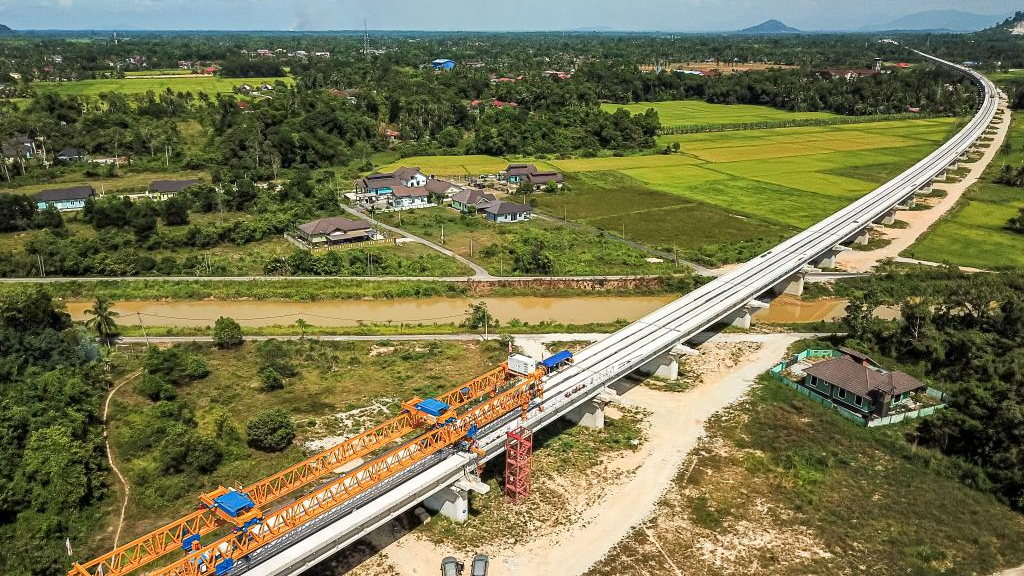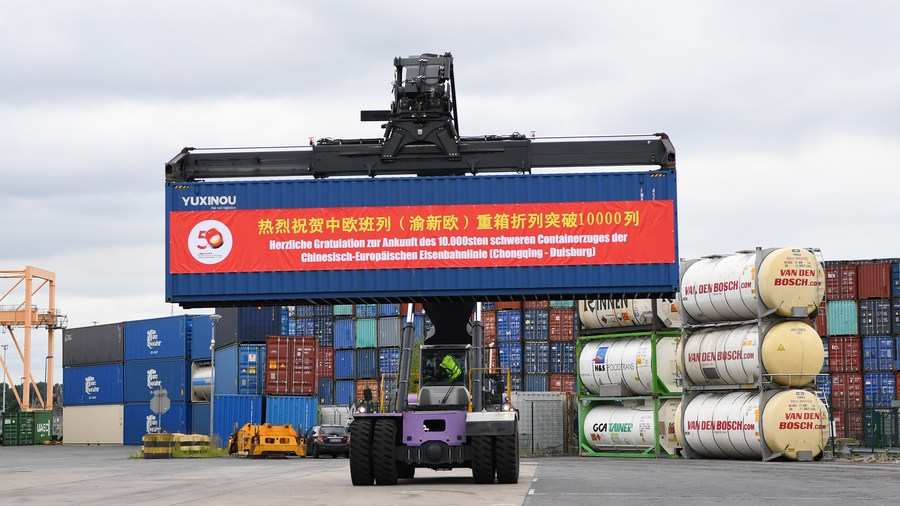
A construction site of the East Coast Rail Link (ECRL), a major infrastructure project under the Belt and Road Initiative (BRI) in Kelantan, Malaysia, April 26, 2023. /Xinhua
A construction site of the East Coast Rail Link (ECRL), a major infrastructure project under the Belt and Road Initiative (BRI) in Kelantan, Malaysia, April 26, 2023. /Xinhua
Editor's note: Aishwarya Sanjukta Roy Proma is a research associate at the BRAC Institute of Governance and Development (BIGD). The article reflects the author's opinions and not necessarily the views of CGTN.
China proposed the Belt and Road Initiative (BRI) in 2013 as a sizable infrastructure development initiative to connect Asia with Europe and Africa along the ancient Silk Road routes through a network of various projects. According to data from the World Bank, the BRI covers 71 economies geographically located along BRI transport corridors, including China, which accounts for 40 percent of global merchandise exports and 35 percent of global foreign direct investments.
The BRI has changed the landscape of infrastructure financing and governance around the world by offering an alternative model to the existing multilateral institutions. It has reshaped regional order and stability in Asia and beyond by creating new partnerships among the countries involved. It has also enhanced China's cooperation and coordination with many countries, especially in Central Asia, South Asia, Southeast Asia, and Africa, where much-needed investment, trade, and development assistance have been provided.
Developing countries see the BRI as a source of financing, investment, trade, and infrastructure development that can boost their economic growth and development. But through a geopolitical lens, a few countries view the BRI as a way to balance or hedge against other regional or global powers, such as the United States or Japan. The BRI can provide alternative sources of security, stability, and leverage for these countries, especially in areas where they face territorial disputes, geopolitical competition, or external pressure.
The BRI has also fostered cross-border cooperation in science, technology, education, and culture, creating new opportunities for innovation and talent development as China's exports of high-tech products to BRI countries have increased by 10.9 percent annually while its imports of high-tech products from BRI countries have increased by 20.1 percent annually.
The BRI has expanded China's export markets and diversified its trade partners, especially in emerging regions such as Africa, Central Asia, and Southeast Asia, and brought multiple economic benefits. Additionally, it has increased China's outbound investment and facilitated its access to natural resources, technology, and markets.
From 2013 to 2020, China's trade volume with BRI countries reached $9.2 trillion. Direct investment from China to those countries reached $140 billion. Over the years, BRI has significantly contributed to global GDP growth, especially for China and other participating countries. It's projected by the Statista that the BRI could increase global GDP by 0.7 percent in 2030 and by 2.6 percent in 2050; and China's GDP could increase by 3.4 percent by 2030 and 5.3 percent by 2050 as a result of the BRI.
The BRI has supported the construction of various transport corridors that link China with its neighboring regions and beyond. For example, the China-Europe Railway Express connects China with Europe through Central Asia and Russia.

A scene from the welcome ceremony for the 10,000th trip made by China-Europe freight trains operated by the China-Europe Railway Express (Chongqing) in Duisburg, Germany, July 11, 2022. /Xinhua
A scene from the welcome ceremony for the 10,000th trip made by China-Europe freight trains operated by the China-Europe Railway Express (Chongqing) in Duisburg, Germany, July 11, 2022. /Xinhua
Trade liberalization and integration have also been promoted under the framework through various free trade agreements, preferential trade arrangements, and regional economic initiatives. For example, China has joined the Regional Comprehensive Economic Partnership, which covers 15 countries in the Asia-Pacific.
Moreover, the BRI has enhanced China's energy security and environmental sustainability by developing clean energy sources such as hydropower, wind power, and solar power. The Initiative has benefited China's economy and contributed to global economic growth and development.
However, some groundless rhetoric has been spread about the project. The U.S. has been concerned about China's growing influence and presence in Asia and beyond. Its view of BRI has also evolved and changed over time, depending on the political context between the two countries. Under the Obama administration, the U.S. adopted a constructive approach to the BRI while also pursuing the rebalance to Asia strategy.
Under the Trump administration, a more competitive approach was adopted toward the BRI while the U.S. also withdrew from some multilateral agreements and institutions. After Biden took office, a more nuanced and balanced approach has been applied to the BRI while also re-engaging with its allies and partners. The U.S. has even sought to offer alternative or complementary initiatives to the BRI.
China has responded to the criticism related to BRI from the U.S. and Western allies in various ways. It has denied that the BRI is a form of "debt trap diplomacy" and argued that lending practices are based on international standards. It has pledged to make the BRI more sustainable, low-carbon, and climate-resilient and to promote green finance and investment along the BRI routes, and shifted its focus from quantity to quality in BRI cooperation.
In conclusion, the BRI has had significant impacts over the past 10 years and has been a game-changer in the global infrastructure development. It has also reshaped the dynamics of cooperation among major powers and regions and generated opportunities for global economic development and cooperation for China and its global outlook.
(If you want to contribute and have specific expertise, please contact us at opinions@cgtn.com. Follow @thouse_opinions on Twitter to discover the latest commentaries in the CGTN Opinion Section.)